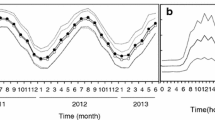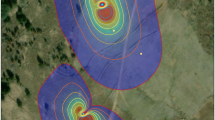Abstract
Small polythene tents were used to simulate the effects of climate warming on two contrasting vegetation types (polar semi-desert and tundra heath) at Ny Ålesund, Spitzbergen, Svalbard. Temperature microclimates are compared within and without tents and between sites with contrasting vegetation types. Summer temperatures were increased by about 5°C in the vegetation mat and by about 2°C in the soil at 3 cm depth. Cumulative day degrees above zero were enhanced by around 35% in the vegetation and by around 9% in the soil. Soil temperatures were greatly influenced by the nature of the overlying vegetation, which at one of the sites appeared to act as an efficient thermal insulator, preventing heat conductance into the soil from above and enhancing thermal contact between the upper soil layer and the cooling permafrost below. The significance of the observed temperature differences for the ecology of the plants and invertebrates is discussed.
Similar content being viewed by others
References
Bolin B, Doos BR, Jager J, Warwick R (1986) The Greenhouse Effect, Climatic Change and Ecosystems. Wiley, London
Corbet PS (1972) The microclimate of arctic plants and animals, on land and in fresh water. Acta Arct 18:1–43
Courtin GM, Labine CL (1977) Microclimatological studies on Truelove Lowland. In: Bliss LC (ed) Truelove Lowland, Devon Island, Canada: a High Arctic Ecosystem. University of Alberta Press, Edmonton, pp 73–106
Danks HV (1981) Arctic Arthropods. A review of systematics and ecology with particular reference to the North American fauna. Entomological Society of Canada, Ottawa
Dingman SL, Barry RG, Weller G, Benson C, Le Drew EF, Goodwin CW (1980) Climate, Snow Cover, Microclimate and Hydrology. In: Brown J et al (eds) An Arctic Ecosystem: The Coastal Tundra at Barrow, Alaska. Dowden, Hutchinson & Ross, Stroudberg, Pennsylvania, pp 30–66
Geiger R (1965) The Climate Near the Ground. Harvard University Press, Cambridge, Massachusetts
Grant WE, French NR (1990) Response of alpine tundra to a changing climate: a hierarchial simulation model. Ecol Modelling 49:205–227
Hansen K (1973) Microthermic observations in arctic vegetation. Meddr Grønland 194:1–32
Kevan PG (1975) Sun tracking solar furnaces in high arctic flowers: significance for pollination and insects. Science 189 (4204):723–726
Masuzawa T, Nishitani S, Suzuki J, Kibe T, Aihara E (1991) Seasonal changes in the soil temperature over a three-year period at the timberline on Mt. Fuji. Report of the Faculty of Science, Shizuoka University 25:69–78
Mitchell JFB, Manabe S, Meleshko V, Tokioka T (1990) Equilibrium climate change and its implications for the future. In: Climate Change. The I.P.C.C. Scientific Assessment. Press Syndicate of the University of Cambridge, pp 131–172
Molgaard P (1982) Temperature observations in high arctic plants in relation to microclimate in the vegetation of Peary Land, North Greenland. Arctic Alpine Res 14:105–115
Nasjonalatlas for Norge (1986) Vegetasjonregioner — Svalbard og Jan Mayen, Hovedtema 4: Vegetasjon og Dyreliv, Kartblad 4.1.3. Norsk Polarinstituut/Mab — Svalsbardsprosjeket
Remmert H, Wunderling K (1970) Temperature differences between arctic and alpine meadows and their ecological significance. Oecologia 4:208–210
Rønning OI (1979) Svalbards Flora. Norsk Polarinstitutt, Oslo
Vassiljevskaya VD, Pospelova EB, Bogatyrev LG (1972) The soil temperature regime in certain tundra types at the Agapa station during the growing season. In: Wielgolaski FE, Rosswall T (eds) Proceedings IV International Meeting on the Biological Productivity of Tundra, Leningrad USSR, October 1971. I.B.P. Tundra Biome Steering Committee, Stockholm, pp 219–228
Walton DWH (1982a) Instruments for measuring biological microclimates for terrestrial habitats in polar and high alpine regions: a review. Arctic Alpine Res 14:275–286
Walton DWH (1982b) The Signy Island reference sites: XV. Microclimate monitoring, 1972–74. B.A.S. Bulletin 55:111–126
Weller G, Holmgren B (1974) The microclimates of the arctic tundra. J appl Met 13:854–862
Weller G, Cubley S, Parker S, Trabant D, Benson C (1972) The lundra microclimate during snow-melt at Barrow Alaska. Arctic 25:291–300
Woodward FI (1987) Climate and Plant Distribution. Cambridge University Press, Cambridge
Author information
Authors and Affiliations
Rights and permissions
About this article
Cite this article
Coulson, S., Hodkinson, I.D., Strathdee, A. et al. Simulated climate change: the interaction between vegetation type and microhabitat temperatures at Ny Ålesund, Svalbard. Polar Biol 13, 67–70 (1993). https://doi.org/10.1007/BF00236585
Received:
Accepted:
Issue Date:
DOI: https://doi.org/10.1007/BF00236585




